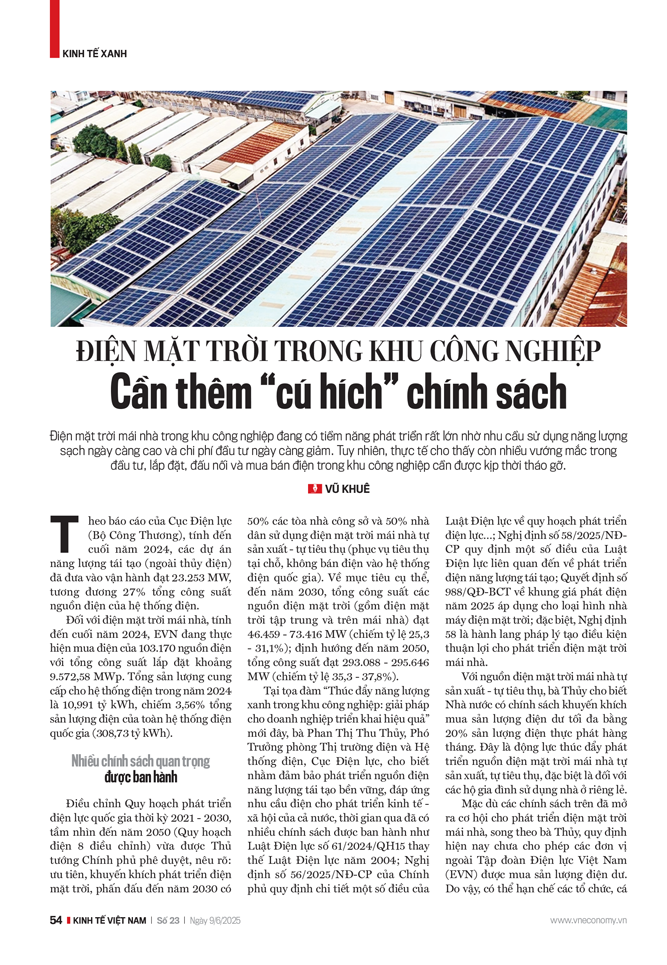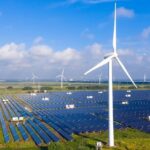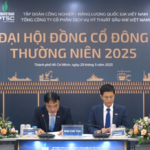According to a report by the Electricity Authority (Ministry of Industry and Trade), by the end of 2024, the total capacity of renewable energy projects (excluding hydropower) in operation reached 23,253 MW, accounting for 27% of the total capacity of the power system.
For rooftop solar power, as of the end of 2024, EVN is purchasing electricity from 103,170 sources with a total installed capacity of approximately 9,572.58 MWp. The total output supplied to the power system in 2024 was 10.991 billion kWh, accounting for 3.56% of the total electricity output of the entire national power system (308.73 billion kWh).
IMPORTANT POLICIES HAVE BEEN ISSUED
The Adjustment of the National Power Development Plan for the period 2021 – 2030, with a vision to 2050 (Power Plan 8 Adjustment) recently approved by the Prime Minister, states: Priority is given to encouraging the development of solar power, striving by 2030 to have 50% of office buildings and 50% of households using rooftop solar power for self-production and self-consumption (serving on-site consumption, not selling electricity to the national power system).
In terms of specific targets, by 2030, the total capacity of solar power sources (including concentrated solar power and rooftop solar power) will reach 46,459 – 73,416 MW (accounting for 25.3 – 31.1%); by 2050, the total capacity will reach 293,088 – 295,646 MW (accounting for 35.3 – 37.8%).
At the recent seminar “Promoting Green Energy in Industrial Parks: Solutions for Enterprises to Implement Effectively”, Ms. Phan Thi Thu Thuy, Deputy Head of the Electricity Market and Power System Department, Electricity Authority, said that in order to ensure the sustainable development of renewable energy sources and meet the electricity needs for socio-economic development of the country, many policies have been issued such as the Law on Electricity No. 61/2024/QH15 replacing the Law on Electricity of 2004; Government Decree No. 56/2025/ND-CP detailing a number of articles of the Law on Electricity on power development planning…; Decree No. 58/2025/ND-CP detailing a number of articles of the Law on Electricity related to the development of renewable energy; Decision No. 988/QD-BCT on the frame electricity price in 2025 applied to solar power plants; especially, Decree 58 is a legal corridor that facilitates the development of rooftop solar power.
Regarding rooftop solar power for self-production and self-consumption, Ms. Thuy said that the State has a policy to encourage the purchase of surplus electricity up to a maximum of 20% of the actual monthly electricity generation. This is an incentive to promote the development of rooftop solar power for self-production and self-consumption, especially for households using separate houses.
Although the above policies have opened up opportunities for the development of rooftop solar power, according to Ms. Thuy, the current regulations do not allow units outside the Vietnam Electricity Group (EVN) to buy surplus electricity. Therefore, it may limit organizations and individuals from developing solar power sources in industrial parks and clusters under the management of the power unit that buys electricity wholesale and retail (not belonging to EVN).
BOTTLENECKS REMAIN TO BE ADDRESSED
Mr. Phan Cong Tien, Energy Expert from the Institute for Smart Energy Application Research (iSEAR), said that Decree No. 57/2025/ND-CP of the Government on the mechanism for direct electricity sale and purchase between renewable energy generators and large power consumers, and Decree No. 58/2025/ND-CP have created an important turning point in promoting flexible energy models, enterprises not only install on-site solar power systems to serve internal needs but are also allowed to buy renewable energy directly from projects far from the load location through the direct power purchase agreement (DPPA) mechanism.
However, there are still bottlenecks in these two decrees. Specifically, with Decree 57, only large power consumers are allowed to purchase electricity, while for retail units in industrial parks, only those with a capacity of 10 MW or more are allowed to purchase electricity through the national grid. However, according to the Law on Electricity 2024, retail companies are allowed to buy electricity for resale to customers and are also not prohibited from installing solar power systems to resell to customers. “Thus, with Decree 57 only allowing EVN to buy surplus electricity from self-producing and self-consuming customers, it is a waste and a big barrier to the greening and energy self-sufficiency of industrial parks,” Mr. Tien emphasized.
In addition, the application of the ceiling price for the DPPA mechanism through a dedicated line is currently causing difficulties for enterprises. In fact, controlling the ceiling price is only really necessary when there are signs of monopoly or unfair competition in the market, and the state intervenes to prevent the act of pushing up prices unreasonably, protecting the interests of consumers.
Regarding Decree 58, many enterprises and customers in the cluster retail model still face difficulties in implementing the installation of solar power for self-production and self-consumption purposes. The reason is that manufacturing customers cannot reach an agreement with the industrial park management unit, although the Decree has clearly stipulated the need to create favorable conditions for customers to install solar power systems in the form of self-production and self-consumption.
On the other hand, Decree 58 stipulates that the capacity of the solar power system for self-production and self-consumption must not exceed the maximum load (Pmax), reducing the economic efficiency of the project. In fact, solar power is a weather-dependent energy source, and the capacity often fluctuates depending on the time of day and radiation. Therefore, to optimize investment efficiency, many enterprises often install solar power systems with a capacity larger than the load.
“This ‘excess capacity’ not only helps to better utilize the energy source at times of weak sunlight but also to store it when combined with a storage system. The excess electricity is then stored for use at times of low sunlight or at night, helping to increase energy self-sufficiency,” Mr. Tien analyzed; at the same time suggesting the removal of the capacity limit, as the system usually has anti-reverse devices, so it does not affect the grid.
POLICIES ALLOWING THE SALE OF ELECTRICITY WITHIN INDUSTRIAL PARKS ARE NEEDED
Regarding the above difficulties, representatives of investors of industrial parks in Hanoi, Hai Phong, Vinh Phuc, Quang Ninh, Bac Ninh, Bac Giang, Hung Yen, Hai Duong, Ha Nam, and Thai Nguyen provinces/cities proposed that the Government and ministries and branches soon issue Circulars, Decrees, and guiding documents to implement Decree No. 57/2025/ND-CP and Decree No. 58/2025/ND-CP. Specifically, it is necessary to issue policies allowing the development of solar power, investment in infrastructure for power supply, connection, and permission to sell electricity in industrial parks to provide clean energy sources for enterprises in industrial parks and clusters.
Specifically, regarding the surplus electricity of the system, solar power depends heavily on the number of sunny hours per year, so the electricity output from the solar power system in the North is much lower than in the South when considering the same technical parameters. Applying a ceiling price based on the common electricity price frame for all geographical areas will be unfair to solar power developers in the North and reduce the attractiveness of this form. Meanwhile, the North needs to prioritize the development of power sources to avoid overloading the North-South power grid and reduce transmission costs. Therefore, there is a need for a separate mechanism for the ceiling price of electricity output from the solar power system in the North to encourage investment.
For the model in industrial parks and clusters, the workshop renter encounters difficulties in the definition of “self-produced and self-consumed electricity”, so enterprises cannot buy renewable energy. Therefore, representatives of some industrial park investment units proposed to include non-state electricity distribution and retail units in industrial parks as one of the subjects in the definition of “Large power consumers” so that these enterprises can sign DPPA with energy development units, thereby creating fair competition and promoting price reduction in the energy market. In addition, just defining “Self-produced and self-consumed electricity” means that the electricity source does not emit into EVN’s grid is in line with today’s economic goals.
Moreover, in terms of implementation procedures, the managing agencies need to soon issue legal documents, which must provide detailed guidance on the order of implementation, procedures for investment, planning, construction, environmental protection, fire prevention and fighting, ensuring consistency and uniformity…
The full content of the article is published in the Vietnam Economic Magazine No. 23-2025 issued on 09/06/2025. Inviting readers to see here: https://postenp.phaha.vn/tap-chi-kinh-te-viet-nam/detail/1440

“The Private Sector: Leading the Charge Towards a Low-Carbon, Green Growth Economy”
Although the nation’s economic growth model remains carbon-intensive, Vietnam’s private sector has begun to seize green growth opportunities. The private sector will also be pivotal in Vietnam’s efforts to reduce emissions and transition to a low-carbon economy.
Unveiling the Revised Power Development Master Plan
The dynamic development of domestic power sources is pivotal, and the Amended Power Development Plan 8 provides a clear strategic direction for electricity import and export within the ASEAN region and the Greater Mekong Subregion.
“Offshore Wind Power: Unlocking Decades of Revenue Potential”
The Annual General Meeting of the Vietnam Petroleum Technical Services Joint Stock Corporation (PTSC) revealed an exciting initiative on May 29. PTSC is currently developing a large-scale offshore wind power complex, with ambitions to supply electricity from Vietnam to Singapore and Malaysia. This venture is estimated to surpass a staggering $10 billion in total investment.





















